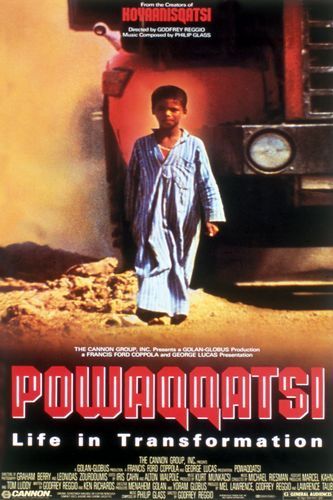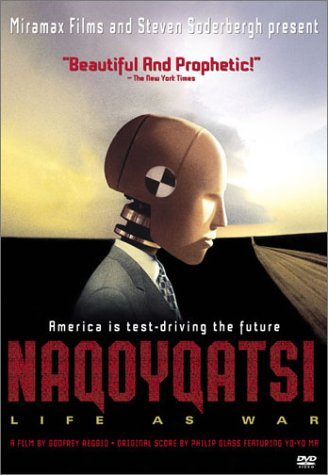Ok, this is gonna be a weird group of movies to review. The Qatsi Trilogy are not your everyday documentary films that show life with either a voice of God narration or interviews throughout. Godfrey Reggio, the director of all three films, simply documents and puts the beautiful images that he captures to the music of master composer, Philip Glass. Without a single word of dialogue, these three films will make you think about the world and your existence like you may have never thought of it before, and will definitely open your eyes to different aspects and places while completely changing your view on the familiar.
Let’s start in 1983 with the first film of the trilogy, Koyaanisqatsi.
Koyaanisqatsi translates to “life out of balance.” What this film shows first is beautiful and monolithic images of nature. The transition is quick as these stone monoliths start being destroyed with the culprit being mankind, and the reason being so that we can construct our own manmade structures. Life of humanity is shown in fast motion photography with symbolism and allegories that can be seen in the editing and the photography itself. Finally, the film ends with a warning against our obsession and reliance on technology that won’t soon be forgotten.
This is one of, if not the most, beautiful and hypnotic films that I have ever seen. The fast motion photography is the most obvious way of showing the speed at which our lives move. We are a civilization that almost seems to never sleep or even slow down. In one particular scene in a train station, we almost seem like insects moving around our mound of dirt. Another scene shows highways with red lights flying through them, which reminded me almost of blood cells traveling through veins and arteries with the city being the hear that keeps it all moving. Images like this really stick out and make the viewer think about what they are seeing, and that’s what makes Koyaanisqatsi so excellent.
I feel like this is more than a film, it’s a cinematic experience that will leave your brain in constant thought and bewilderment. You’ll ponder your existence and the effect that your existence has on the world around you. You may even be torn on the true meaning of the movie, whether it’s a good or bad one. That’s part of the brilliance of this movie, the ambiguity mixed with the power of the visuals and fantastic music. This is definitely one to check out and be amazed.
In 1988 the sequel was released, Powaqqatsi.
As the poster shows, Powaqqatsi translates to “life in transformation.” This film is about life in multiple third world and developing countries, and how they are growing and constantly evolving. There is also a theme that can be noticed about the west’s cultures effects on these more eastern civilizations. The film starts out slowly with tribal rituals, and small villages in their own everyday lives. A train is a transition to urban development which is quicker than what was shown before, but still nowhere near as fast as the photography in Koyaanisqatsi.
The reason why it is so slow is to show the contrast of more modernized society. The lives these individuals live seem to be more focused and, in our view, slowed down. The photography is still beautiful and the music by Philip Glass is still great. This is definitely not as great a movie as its predecessor, however. Nowhere near. I understand the need for the slow motion, but it didn’t keep me too interested for the entire run of the movie. It also seemed very haphazardly edited. Koyaanisqatsi almost had a narrative that was hidden in the fluidity of the movie. Powaqqatsi seemed more like a film that was thrown together. It made it much less interesting than it could have been.
Powaqqatsi was still an engaging and beautiful movie with powerful music to match. It still makes you think about your life, but this time with the knowledge of how other people live. It’s jarring and strangely inspirational. The only thing that could have improved this movie is better pacing, a shorter run time, and a more strategically constructed narrative. This isn’t a necessary film to watch, but I can understand why it was made.
Finally, in 2002, Godfrey Reggio released the final film of his trilogy: Naqoyqatsi.
Naqoyqatsi translates to “life as war.” This is the black sheep out of the three films with a lot of its footage coming from archival videos and television. The themes that are tackled range from the follies and plasticity of celebrity life to the tragic apex of technology and life: war. Phillip Glass’ music still plays a big part in this film, but the footage itself is much more digitized with a lot of special effects to really stress the notion of technology.
I’m really torn over this one. Part of me wants to like this one more than Powaqqatsi, but the other part of me tells me that that’s impossible. It certainly kept my attention more and the themes constructed more of a narrative, but the work that went into both of its predecessors completely seems to outdo the work put into this film. The effects were really cool, but soon got to be a bit overdone to the point that it was distracting. Glass’ music is also completely unmemorable. I can hum some parts from the other two films, but can’t seem to remember any of the music from this one.
My main problems with Naqoyqatsi are that it seems overblown with cool effects and it is altogether just not as powerful. It certainly doesn’t match the beauty of Koyaanisqatsi and Powaqqatsi. It still does have a powerful message that can be connected to the messages of Koyaanisqatsi, so in that way, it’s a fitting conclusion to the trilogy, but is the weakest in my opinion.
The Qatsi Trilogy is an incredible cinematic experience that is very difficult to explain, and is something that really must be seen. While I do have some gripes with the second and third entries, they still provide a powerful trip into different parts of the world and different parts of our minds. They are a perfect combination of music and images and experimental and documentary. I can’t recommend these movies to everyone, because it’s certainly not going to appeal to a national audience. For the people who find themselves interested in these ideas, check them out if you haven’t already.





